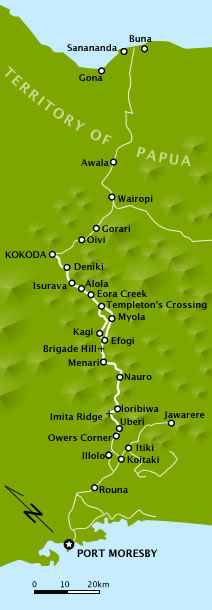
Click here for lyrics
On 23rd January 1942 the Japanese captured Rabaul, a township on the northern tip of New Britain island that was the capital of the Australian-administered Territory of New Guinea, with minimal resistance. On 21st July they established beachheads at Buna and Gona 600 kms south on the New Guinea mainland.
But firstly, the Guadalcanal Campaign
Guadalcanal, the principal island in the South Solomon Islands was captured by the Japanese in May, but Allied forces, predominantly the US, captured the airfield they were constructing on the island, also capturing two islands nearby, in a surprise attack under the cover of bad weather on 7 August, arriving there from their base at Espiritu Santo in Vanuatu.
Five weeks later, Japanese commander Lieutenant General Harukichi Hyakutake's thrust on 14 September 1942 to re-take the island's airfield was badly defeated. In an unequal battle, Kawaguchi's Japanese forces lost about 850 killed, while the American marines lost 104. When the news reached Imperial General Headquarters in Japan, they decided in an emergency session that they could not support fronts on both New Guinea and Guadalcanal. Hyakutake decided that he only had sufficient troops and materiel to defeat the Allied forces on Guadalcanal, though even in that he was unsuccessful, eventually pulling out in February, 1943. But following his earlier defeat, he prepared to send more troops to Guadalcanal in September to attempt to recapture the airfield.

|
Back to General Horii on the Kokoda Track
On 26th September, with the concurrence of the Japanese command staff, Hyakutake ordered General Horii on the Kokoda Track that led to Port Moresby, to withdraw his troops to a holding position until the issue at Guadalcanal was decided. The Japanese troops were at that very moment, after several weeks of exhausting fighting the Australians and suffering heavy losses, within 32 kilometres of Port Moresby. The lead elements could in fact see its lights and had begun celebrating.
Needless to say, General Horii and his troops were disheartened to learn their sacrifice and those of their dead companions, many thousands, was to be for nothing (from their perspective). On 28 September they withdrew northwards back over the Owen Stanley Mountains, while maintaining a well-ordered rearguard action. Final defeat for the Japanese on New Guinea's mainland came four months later when their organized resistance ended on 22nd January 1943, though significant numbers still remained at large to be dealt with over the following days. This defeat for them on the Kokoda Trail has been documented as involving three separate campaigns,
The Kokoda Trail was in fact the first time a Japanese advance had been stopped in the Pacific. It had been a total of 13,500 Japanese that had landed in the north of Eastern Papua for the fighting during the campaign. Of these, about 6,000 or two regiments, were directly involved in the "forward areas" along the 96 kilometre track that led south from Kokoda to Port Moresby. Against this, the Allies assembled approximately 30,000 troops in Port Moresby, although at any one time no more than one infantry brigade, or approximately 3,500 troops, were involved in the fighting for most of the campaign.
Aftermath Fighting continued on northern beaches, Lae freed in September 1943, Aitape and Madang April 1944, and after Japan mostly restricted to, and hedged in at Wewak and Rabaul, suffering from bombing raids (milk runs) up until their surrender 13 September 1945. Click here for further background to the Battle in the Pacific.
Now for the "running rabbits" incident
On 22 October 1942 after the relief of the 21st Brigade by the 25th Brigade, the Australian commander of Allied Land Forces—General Sir Thomas Blamey visited the remnants of Maroubra Force at Koitaki camp near Port Moresby.
Blamey had relieved Brigadier Potts of his command, replacing him with Brigadier Ivan Dougherty, an officer he knew from when Blamey commanded the Northern Territory Force. Blamey cited Potts' failure to resist the Japanese despite commanding "superior forces" — no comment made about the supplies and disease issues Potts had had to deal with — and despite explicit orders to the contrary, Potts' failure in August to launch an offensive to re-take Kokoda. Blamey explained that the current Labour Prime Minister of Australia, John Curtin, had told him to say that failures like Kokoda would not be tolerated.
Shortly after relieving Potts, Blamey addressed the men of the 21st Brigade on a parade ground. The men of the Maroubra Force expected congratulations for their efforts in holding back the Japanese. However, instead of praising them, Blamey told the brigade that they had been "beaten" by inferior forces, and that "no soldier should be afraid to die". "Remember," Blamey was reported as saying, "it's the rabbit who runs who gets shot, not the man holding the gun." There was a wave of murmurs and restlessness among the soldiers. Officers and senior non-commissioned officers (NCOs) managed to quiet the soldiers and many later said that Blamey was lucky to escape with his life. Later that day, during a march-past parade, many disobeyed the "eyes right" order. In a later letter to his wife, an enraged Brigadier Potts swore to "fry his [Blamey's] soul in the afterlife" over this incident. According to witnesses, when Blamey subsequently visited Australian wounded in the camp hospital, inmates nibbled lettuce, while wrinkling their noses and whispering "run, rabbit, run" (the chorus of this popular song during the war).
Right click here to view source